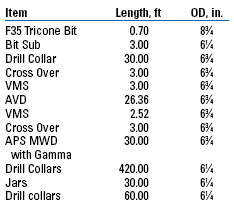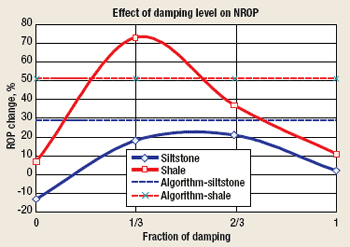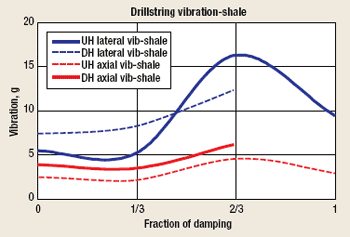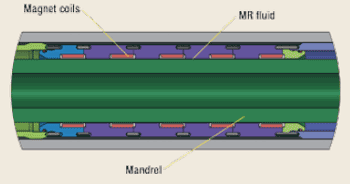The new tool improves drilling efficiency.
Mark E. Wassell and Martin E. Cobern, APS Technology Inc.; Vishal Saheta and Arifin Purwanto, Smith International; and Mandy Cepeda, Rocky Mountain Oilfield Testing Center
A novel tool designed to detect and react to drillbit vibration was tested at the Rocky Mountain Oilfield Testing Center (RMOTC), located in Teapot Dome Oil Field, also known as Naval Petroleum Reserve No. 3 (NPR-3), near Casper, Wyoming. This new tool, the Active Vibration Damper (AVD), developed by APS Technology, Inc., monitors vibrations in the BHA and adjusts the damping coefficient to reduce them. This was the first field test of the device, which had previously been tested at a drilling laboratory.1
INTRODUCTION
The AVD was developed under contract with the US Department of Energy Deep Trek Program. Smith Services is the commercial partner and collaborator in the testing and potential commercialization of the tool. Smith and APS partnered with RMOTC to conduct a test of the AVD in a field with an extensive drilling history for comparison.
The RMOTC tests showed the AVD improves drilling economics in two areas: It increases ROP while minimizing vibration. The AVD measures and adjusts the stiffness of the BHA in response to changes in load variations while drilling. This helps maintain constant Weight On Bit (WOB) and improves the cutting efficiency of the bit, increasing the Rate Of Penetration (ROP). The AVD also reduces drillstring vibrations. By reducing the vibration that can damage the bit and other drillstring components, the AVD allows longer bit runs and reduces unplanned trips.
Axial vibrations cause significant fluctuations in WOB and even bit bounce. Optimum damping provides a more consistent WOB, which results in less cutter breakage and wear, and therefore higher ROP and longer bit life. Vibration can also be detrimental to the longevity of drillstring components, like the MWD/LWD electronics, and can damage rotary connections.
As was seen in these tests, lateral vibrations caused by the rotating drillstring can transform into axial vibrations. This is an important finding regarding the mechanism of vibration damage to the bit. This leads to bearing problems and broken or lost teeth. The rocking action also creates higher side impact loads, which accelerates gage wear in abrasive formations. Lateral vibrations typically have a significantly greater magnitude than axial vibrations, and the AVD helps to decouple the two.
DESCRIPTION OF THE AVD
The AVD tool performs like the active shock absorber on high-end sports cars.2 The lower end looks very much like a conventional shock sub with a Belleville spring stack and radial and torsional bearings. The upper module contains electronics that measure the mandrel movements and adjusts the electrical current level in the damper module in response to them. The center module houses the damper. The damper module has two chambers separated by a restriction surrounded by a series of electric coils, Fig. 1. A MagnetoRheological Fluid (MRF) is used as the damper fluid. As the electrical current to the coils increases, the magnetic field in the damper gets stronger, this, in turn, increases the viscosity of the MRF, thereby increasing the dynamic stiffness of the tool. Laboratory tests showed that the dynamic stiffness can be varied by a factor of 7:1, resulting in a range of effective dynamic spring rate of the tool between 15,000 lb/in. and 98,800 lb/in.3
FIELD TEST
The intent of the field test was to determine how different levels of damping affected the ROP so that the computerized damper algorithm could be refined. A test matrix called for varying the WOB, rotary speed and damping while drilling through a known interval of formations. The WOBs were 15,000, 25,000 and 35,000 lb. The rotational speeds were 60, 80 and 100 rpm. The AVD damping levels were off, one-third power, two-thirds power and full power. Finally, a closed-loop algorithm was used that varied the power based on the current measured; such an algorithm is used in the commercial tool.
The field test took place at Well 45-4-X-21 at NPR-3 in July 2007. Based on offset well information, the interval drilled is known for hard drilling conditions that produce significant drillstring vibration. The interval consisted of shale and siltstone. The typical ROP for this interval is 5-15 ft/hr. A “slick” BHA was chosen to encourage high levels of drillstring vibration, Table 1. (A baseline test was also run without the AVD in the BHA.)
| TABLE 1. Field test bottomhole assembly |
 |
|
Downhole data measurements were made using two Vibration Monitoring Subs (VMS).4 Each sub measured and recorded the vibration in three orthogonal orientations: one axial and two transverse. The tool recorded the maximum and Root Mean Squared (RMS) vibration levels for each of the three accelerometers every 4 sec. for downloading at the surface after each test run. It also stored four detailed burst data records. These burst records (20-sec. raw data samples recorded at 1,000 Hz) were triggered when vibration levels exceed the thresholds of 10, 25, 50 and 75 g.
The BHA also included an MWD tool with gamma to correlate the changes in formation to the offset wells. It also was used to measure the directional control of the BHA. Surface measurements recorded the RPM, WOB and ROP vs. depth during the test. The AVD tool’s damping level could be set at the surface and changed while downhole using a time-based flow control method.
RESULTS
Normalized ROP and vibration data were examined.
Normalized ROP test results. The data was analyzed by Smith Technologies using its proprietary analysis tools that utilize the input drilling variables on a real time basis, with offset well and test well logs, to calculate the unconfined compressive strength of the rock on a foot-by-foot basis. This allowed the company to normalize as many variables as possible and isolate the impact of the AVD had on the drilling outcome, expressed as Normalized ROP (NROP).
Results showed that the damping levels had a significant influence on the differential NROP. With the optimal damping, the AVD increased NROP up to 73% in the softer formations and 29% for harder formations, Fig. 2. Conversely, when the damping was less than optimal, drilling performance suffered and in some instances resulted in an NROP less than those achieved without the AVD. While these measurements over a short interval may not be typical, they do illustrate the potential value of this tool.
|

|
|
Fig. 2. Effect of damping level on NROP.
|
|
The overall improvement in the ROP is obscured in some cases for the following reason. Bit bounce, which is removed by AVD, may sometimes increase the instantaneous ROP, but at the expense of bit life. In hard formations, bearing wear, lost teeth or cones will require additional trips. Some rigs regularly trip prematurely to avoid such problems; this will no longer be necessary with the use of the AVD.
Of particular interest are the results with the AVD tool set to 0% damping. With this setting, the tool acts as a standard shock sub. Drilling the softer shale in this mode resulted in a slight, 7% improvement; however, in the harder siltstone formation, the NROP actually decreases by 13%. This illustrates that conventional shock subs may not always provide benefits in all formation types.
As a commercial tool, the AVD will run as an autonomous closed-loop system using an algorithm to detect changes in mandrel movements and set the appropriate amount of damping in response to these changes. In the harder siltstone formations, the algorithm did better than with the tool set at a constant setting. In the softer shales, the algorithm increased NROP significantly, about 50%, but somewhat less than for a constant one-third damping level. This illustrates that the algorithm needs some adjustment to produce truly optimal ROP for all formation compressive strengths.
Vibration test results. The burst data from the VMSs give some interesting results. A Fourier analysis shows that both 1x and 3x the rotary speed have strong responses, Figs. 3 and 4. Additionally, the lower tool measured strong responses at frequencies between 100 Hz and 140 Hz. These are believed to be induced by the three-cone bit inserts. The upper tool also shows the 1x and 3x frequencies; however, the higher resonances are significantly reduced. They are being filtered out by the AVD tool, reducing the potential damage to components above the AVD. Figures 5 and 6, which display RMS vibration values vs. damping level, show that at one-third damping, for example, the axial and lateral vibration are minimized for both the uphole and the downhole sub. Thus the AVD is not only reducing vibration in the drillstring, but also at the bit, which results in the increased ROP noted in the test.
|

|
|
Fig. 3. Vibration frequencies, lower VMS.
Click image to enlarge.
|
|
|

|
|
Fig. 4. Vibration frequencies, upper VMS.
Click image to enlarge.
|
|
|

|
|
Fig. 5. Drillstring vibration, shale.
|
|
|

|
|
Fig. 6. Drillstring vibration, siltstone.
|
|
CONCLUSIONS
The AVD tool significantly improved drilling performance in this test. In shale the NROP increased by 73% and in siltstone the increase was 29%. The AVD responded to changes in lithology while drilling by changing the damping level, so increases in NROP were maintained. Optimizing the damping level in the tool minimizes vibration, both above and below the AVD. The AVD filters out the higher frequencies above the tool.
Based on these results, the AVD’s ability to actively monitor and respond to drilling vibrations will increase NROP by keeping the bit in more uniform contact with the rock face, thus improving drilling efficiency. It will increase bit life by eliminating shock and vibration damage. It will improve footage per bit, reduced the number of trips to drill the interval and increase downhole sensor life.
Over the past year, additional field testing in rocks of very high compressive strength, such as the Travis Peak, indicate that there is a significant reduction in broken teeth and greater than 10% improvement in ROP, which is in line with the findings from the harder rocks at RMOTC. And, in a deep, heavy oil base mud application in West Texas, both a rock bit and a heavy-set PDC bit showed significant measurable improvements in both ROP and footage drilled per bit run compared to offsets. A number of additional tests are planned in the near future. The results will be discussed in greater detail in subsequent papers. 
LITERATURE CITED
1 Cobern, M.E. et al., “Drilling tests of an active vibration damper,” presented at the 2007 SPE/IADC Drilling Conference, Amsterdam, Feb. 20-22, 2007. SPE/IADC 105400.
2 St. Antoine, A., “First drive: 2007 Ferrari 599 GTB Fiorano,” Motor Trend, July 2006, pp. 64 ff.
3 Cobern, M. E. and M. E. Wassell, “Laboratory testing of an active drilling vibration monitoring & control system,” presented at the AADE 2005 National Technical Conference and Exhibition, Houston, April 5-7, 2005. AADE-05-NTCE-25.
4 APS Technology, “Technical data sheet: Vibration Memory Sub (VMS),” 2008, http://aps-tech.com/tds/APS-VibMemSub.pdf..
|
THE AUTHORS
|
| |
Mark E. Wassell is Analytical Engineering Manager of APS Technology. He is recognized as a leading expert in drilling dynamics with over 25 years of oilfield experience. Mark has been granted numerous patents and published several technical papers. Prior to joining APS, he worked for Ingersol-Rand, Teleco and Baker Hughes INTEQ. He has a BS degree in mechanical engineering from the University of Arizona.
|
|
| |
Martin E. Cobern is Vice President, Research & Development of APS, where he is responsible for the development and commercialization of the company’s proprietary products and technology. He has 30 years of experience in the development of downhole sensors and systems and eight patents in the field. He holds a PhD in physics from Yale University.
|
|
| |
Vishal Saheta is Engineering Supervisor for Smith Services, currently working with drilling tools. He has nine years of experience in engineering and oilfield services. He has an MS degree in mechanical engineering from Purdue University.
|
|
| |
Arifin Purwanto does drill bit optimization for Smith Technology. He is currently working on real-time optimization. He has over 17 years of experience in oil and gas field services. He has a degree in electronic engineering from the University of Indonesia.
|
|
| |
Mandy Cepeda joined the RMOTC staff as a technical writer/editor in November 2006. Her previous experience includes reporting, copy editing, graphic design and marketing. She has a BA in journalism from the University of Wyoming.
|
|
|









